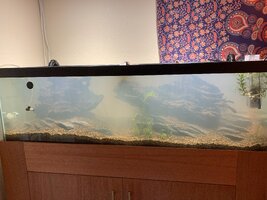Hello all.
I started a new tank 3 weeks ago, and it is very cloudy
As it is a new tank, I would attribute to this to bacterial bloom, but I also used Safe-T-Sorb (a calcined clay product) as the substrate, which is known for having a lot of fine sediment in it.
If the cloudiness is bacterial, I would just let it be, but if it is caused by sediment, I would take measures to clean it. So I'm in a bit of a dilemma.
More info:
It has been cloudy from Day 1.
It has no livestock except for a few pest snails and a some struggling rotala.
The cloudiness has a brown tinge. But there are also large pieces of new driftwood in the tank which may be coloring the water.
Normally, when I check the filter, the filter floss looks very clean, like it's not catching anything. However, I tried a product called Acurel F, which I believe is a flocculant, and the cloudiness cleared right up, and the filter floss quickly became very dirty. This was nice, but the cloudiness soon returned. When I squeezed the filter floss out, it was filled with loads of blackish dirt. This makes me think sediment, but I don't know much about these things.
For a while, I was adding the Acurel F and squeezing out the floss daily, but I ran out of Acurel F and I'm undecided on whether I was really accomplishing anything.
I have been dosing fertilizer (macros and micros) on behalf of the rotala.
I have added large amounts of sodium bicarbonate and GH booster to counteract the water softening properties of the calcined clay, but the chemistry of it all is a bit above my head. I basically just trawl forums like this and do what smarter people tell me to do.
The tank has gone through three 50% water changes so far.
In conclusion,
I don't know whether I should (a) let the tank be, (b) continue the Acurel F + floss squeezing regime or (c) do a lot of water changes.
...and thank you to anyone who has read this whole manifesto!
I started a new tank 3 weeks ago, and it is very cloudy
As it is a new tank, I would attribute to this to bacterial bloom, but I also used Safe-T-Sorb (a calcined clay product) as the substrate, which is known for having a lot of fine sediment in it.
If the cloudiness is bacterial, I would just let it be, but if it is caused by sediment, I would take measures to clean it. So I'm in a bit of a dilemma.
More info:
It has been cloudy from Day 1.
It has no livestock except for a few pest snails and a some struggling rotala.
The cloudiness has a brown tinge. But there are also large pieces of new driftwood in the tank which may be coloring the water.
Normally, when I check the filter, the filter floss looks very clean, like it's not catching anything. However, I tried a product called Acurel F, which I believe is a flocculant, and the cloudiness cleared right up, and the filter floss quickly became very dirty. This was nice, but the cloudiness soon returned. When I squeezed the filter floss out, it was filled with loads of blackish dirt. This makes me think sediment, but I don't know much about these things.
For a while, I was adding the Acurel F and squeezing out the floss daily, but I ran out of Acurel F and I'm undecided on whether I was really accomplishing anything.
I have been dosing fertilizer (macros and micros) on behalf of the rotala.
I have added large amounts of sodium bicarbonate and GH booster to counteract the water softening properties of the calcined clay, but the chemistry of it all is a bit above my head. I basically just trawl forums like this and do what smarter people tell me to do.
The tank has gone through three 50% water changes so far.
In conclusion,
I don't know whether I should (a) let the tank be, (b) continue the Acurel F + floss squeezing regime or (c) do a lot of water changes.
...and thank you to anyone who has read this whole manifesto!



